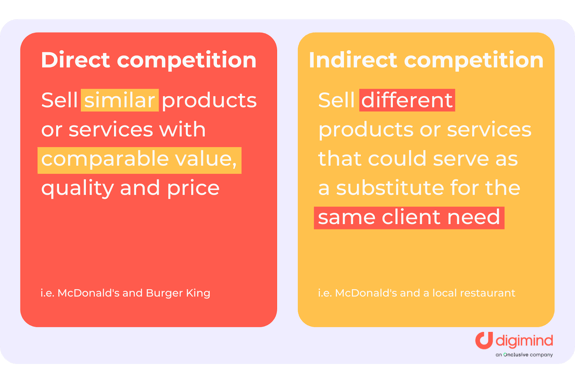How to Do Competitor Benchmarking on Social Media?
Are you worried that your competitor is accumulating more likes than you on LinkedIn? Without the right data you need, you can’t draw concrete conclusions about the effectiveness of your online strategy versus your competitors.
Suppose you are in the business of improving your online performance. In that case, especially if you'd want to know how your competitors are doing–you can conduct a competitive analysis of social networks.
This blog will give you steps to conduct your social media competitive analysis.
Why Should You Do a Competitor Benchmarking of Social Media?
Competitive benchmarking is about collecting data on social media performance and comparing it to your own to help you understand where you stand in relation to industry leaders, the industry average, and specific competitors.
The goal of benchmarking is to continuously evaluate the performance of your products, services, brands, and your organization against your competitors and leaders to improve them. It is a process you must put in place permanently, beyond a one-time competitive study.
Thanks to this analysis, you will be able to:
- Identify your social media competitors
- Know which social platforms they're active
- Measure the frequency of the use of their platform
- Understand their social strategy and conclude if it’s either working or not
- Find gaps in your own social media marketing strategy
- Identify social threats to your business
- Benchmark your social results against the competition
- Finally, position your company to improve your social strategy based on the benchmarking data collected!
What to Analyze on Competitors' Social Networks?
Among the metrics to analyze, you should keep an eye on the following:
- Observable performance metrics on companies’ social profiles (followers growth, number of posts published, frequency, number of interactions received by your content, average response time, etc., to compare with your competitors)
- Raw data about the company outside its profile (mentions, interactions, volume of posts about its products or services, keywords, or hashtags)
For the second type of data mentioned, competitive analysis tools such as Digimind are very helpful. Social listening platforms, by nature, offer a host of ways to compare the performance metrics of each profile but also keep track of all the mentions or comments about their products on the web and social networks.
4 Easy Steps to Follow to Conduct a Social Media Competitor Benchmarking
If you want to conduct a social media competitor analysis but you don’t know where to start, here are four steps that you could follow:
- Define your social media needs and goals
- Select your valuable KPIs
- Identify your industry and competitors' accounts
- Get a social media benchmarking tool to make the process easier
Let’s look at each step for your performance and growth on social media.
#1. Define Your Social Media Needs and Goals
Before starting a benchmark, ask yourself why you want to do it. Is there something lacking in your current social network strategy? What do you seek to achieve out of this?
Before you start measuring performance, knowing precisely what you are measuring and why you need to measure it is essential... Do you want to look at a content analysis? Or do you want to understand the engagement rates in your industry?
Depending on your needs, you’ll have to choose the right platform. For instance, if you’re looking for the best engagement rate, you should do TikTok videos. However, if you want to target a specific audience, you can analyze each of your social media audiences. This way, you can choose a platform accordingly to your needs.
#2. Select Your Valuable KPIs
Now that you know why you want to conduct a competitive analysis of social networks, you need to identify the most important statistics for your strategy. The social benchmarking you plan to do depends on your business objectives.
If you don't have a preference or priority, we recommend starting with quantitative data such as community growth metrics and posting frequency. Then you can move on to qualitative data such as types of posts or general sentiment around the brand, a specific product, or a service.
#3. Identify Your Industry and Competitors' Accounts
Your benchmark will compare your data against your competitors. Thus, you must identify and select the competitors you wish to evaluate. Do you want to target only direct competitors or also indirect ones?

Difference between direct and indirect competition
Your product is an excellent place to start if you need help knowing where or what topics are suitable to begin your competitive benchmark process. That way, you can identify competitors directly competing with your business. A thorough understanding of your product and its value to your customers is essential to determine your direct competitors and their strategy.
For example, if you work for a jewelry brand, you are not just competing with other jewelry brands. You're also competing with major jewelry retailers, in addition to the rest of the various companies and players that create jewelry. Only by looking at your product and assessing its value (the raw material of gold or silver, for example, but also that people can assess them based on durability, waterproof use, or style) will you realize the full extent of your competition.
So, to identify these direct competitors, you have several methods:
- Market research: look at the market for your product and evaluate what other companies are selling a similar product.
- Your customer's voice: they are the key to discovering your direct competitors. You can ask them what other companies/products they have evaluated. They often reveal unexpected competitors you didn't know existed.
- Online communities: your potential customers often seek advice and recommendations on social media sites, apps, or on community forums. Consult them to find some competitors!
Then, what about indirect competitors? 🤔
Firstly, if you are contemplating if you should or shouldn’t include them in your analysis, we recommend you focus on them simply because they have as much influence as your direct competitors regarding your sales process.
Since your indirect competitors often write competitive content against yours, they have an even more important impact on leads for the first steps of the buying process. So how to find these company names and track them effectively?
This time, you can conduct a keyword search. By doing an SEO analysis, you will discover who’s fighting to appear on Google search results. In the end, you are indirectly competing with all the companies that want to shine on the exact keywords as yours.
Take a look at the competition level of each keyword. If any particular keyword's difficulty is high, it may take some effort to put your brand in front. You can do your due diligence by checking your competitors' purchasing ads for them. If websites pay for paid space on the search engine results page for a keyword, they compete with your content for space on Google.
To further maximize your results, you can read our blog highlighting five valuable tips on beating up the competition using market research.
#4. Get a Social Media Benchmarking Tool to Make Your Process Tenfolds Easier
Now that you know why having a competitive analysis is critical and have a stronger sense of your priority indicators and which companies to compare to, you're able to start benchmarking companies' social media.
Say you decide to do it on your own. You'll likely dedicate some time to your research and analysis. Sometimes, it could take a while to find the statistical data, to find both quantitative and qualitative data on social media.
However, if you want a more manageable process, you should use a market intelligence tool such as Digimind that will save you plenty of time.
Here’s how you can use Digimind for competitor benchmarking on social media.
You can quickly look at the social media analytics of your owned accounts via an automated dashboard. You can track the results of many social media accounts simultaneously. In addition, strong social listening tools offer customized options, such as setting alerts and generating curated reports on a schedule for desired stakeholders to receive…
This way, you’ll be able to easily have a look at statistics, reach, impressions, engagement, and all those key metrics in an all-in-one platform. If tracking historical performance is important for your brand, you can put your performance in perspective on a longitudinal level with your competitors by benchmarking through different periods.
Furthermore, you can monitor several products, services, or industries at the same time. Digimind will increase your efficiency when it comes to doing your social media competitor benchmarking.
Lastly, compared to tools that only compare statistics and figures, ours retrieve data over the years, such as online mentions. You can see the evolution of the mentions associated with your brand yearly, monthly, or daily, as well as the overall sentiment associated with it!
Indeed, thanks to artificial intelligence, Digimind can determine if a mention of your brand is positive, neutral, or negative. Then, you’ll also be able to have an idea about your brand reputation.
If you want to learn more about tips and tricks to evaluate your brand reputation, download our free e-book “10 Best Practices for Evaluating Your Brand Reputation”.
Top 10 Competitive Intelligence Tools 2022
Written by Léa BOUTRON
Léa is a French native with a double technological and managerial background who, in addition to being passionate about new technologies, loves working in an international environment. That's why, after professional experiences in the Netherlands or Spain, she joined Digimind Singapore to work on the APAC market.

